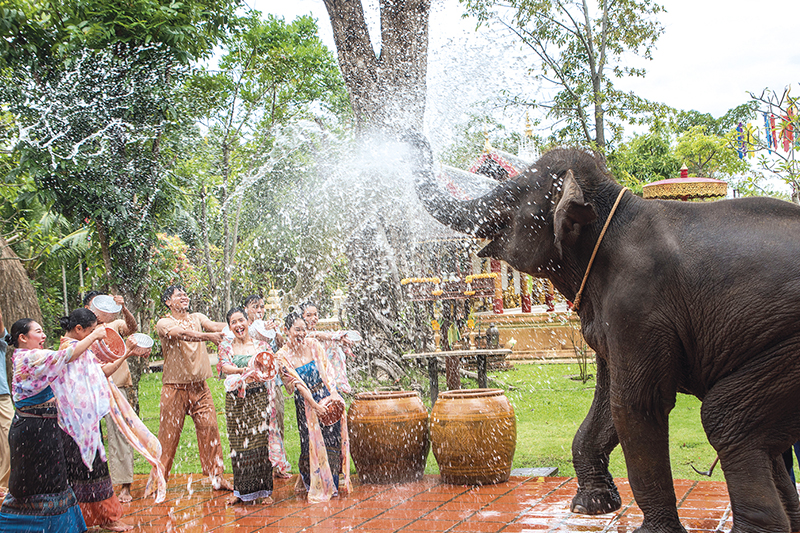
Submerge Yourself in Songkran
Need a little help navigating Thai New Year? Check out our guide to the wildest water wars plus unique and gentle traditions.
Words: Suthima T.
Songkran, or Thai New Year, is a unique celebration that’s rich in history and tradition. Thais celebrate the festival by making merit, visiting temples, giving donations, cleaning their homes, bathing Buddha statues, paying homage to their ancestors and pouring scented water on parents and the elderly. But the celebrations also have a wilder side. The belief is that these acts will wash away the previous year’s bad karma and leave the slate clean for the new year. This three-day holiday also gives families the opportunity to reunite. Most people know Songkran as the water festival, when streets are closed to traffic and they turn into fun-filled battlegrounds, with everybody, young and old, splashing each other with water – buckets of icy cold water in some cases. For a true experience of Songkran, check out the guide on the next pages, which tells you what you need to know about the festival, how you can be part of it, how it is celebrated in different parts of the country, and the best places to go.
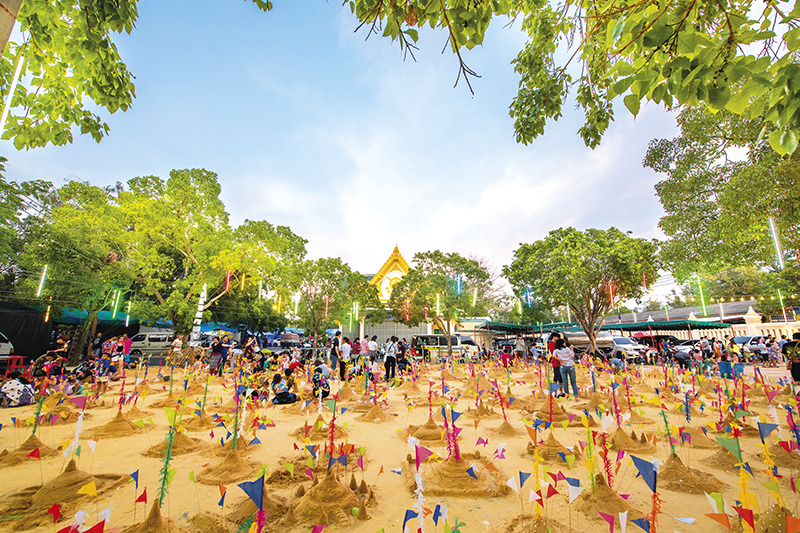
CENTRAL
Songkran in the Central Region starts on April 13, the day of Maha Songkran, when the sun enters Aries, marking the last day of the year. The following day is called Wan Nao, or the day the old year transitions into the new year. April 15 is Wan Thaloeng Suk or New Year’s Day. During these three days, people host religious ceremonies, visit temples, make merit and pay respect to the elderly. This is also the time when Buddha statues are bathed with scented water.
Songkran is inspired by different mythological stories. In one, the god Brahma notices a clever young man who can understand the language of birds. Jealous of his intelligence, Brahma comes down to Earth and poses him a riddle. If the boy gets the answer wrong, he loses his head. But if he gets it right, Brahma will lose one of his heads. The young man despairs, but then overhears a conversation between two birds who let slip the answer.
Presented with the answer, Brahma agrees to cut off his own head, but realises that it will destroy the Earth if it falls form Heaven. So he has one of his daughters carry his head to Mount Meru, saving humankind from destruction. This myth is repeated on Songkran with joyful processions to temples.
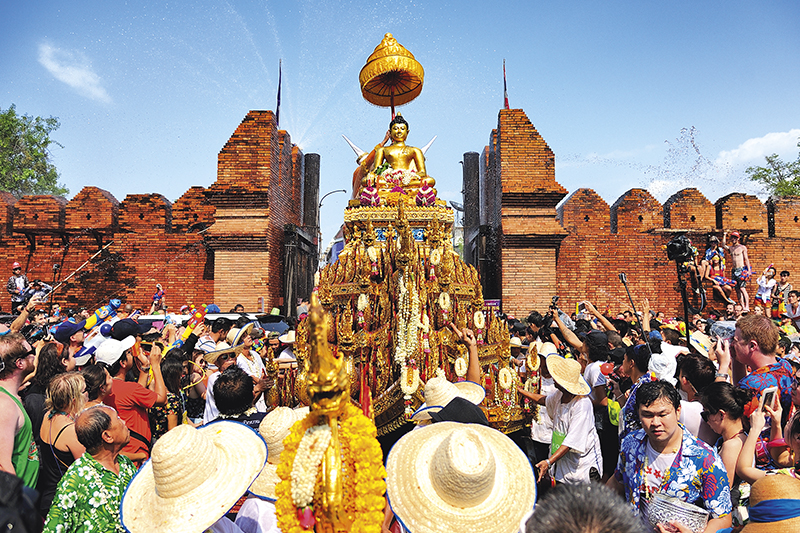
NORTH
According to Lanna tradition, the festival is called Pee Mai Muang. It starts on April 13 when people set off firecrackers to banish bad luck, give their homes a good spring cleaning, and wear new clothes. On April 14, people make an effort to be mindful of their speech, in the belief that bad words will bring bad luck. They also spend the day preparing food and decorating their homes for the big da – April 15. On New Year’s Day, people visit temples to make merit for their ancestors, bathe Buddha statues and honour their elders by pouring scented water on their hands and asking for blessings. They also believe that eating Larb – a spicy minced meat salad, the name of which sounds like the word for luck in Thai – will bring them good luck. Don’t forget to try this dish, but only if you can take the spicy heat.
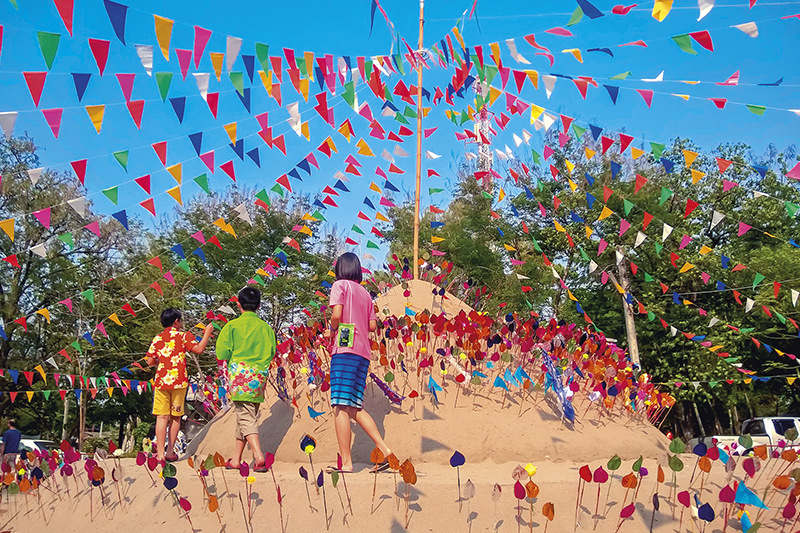
NORTHEAST
Northeasterners mark the New Year at exactly 3pm on the 15th day of the fifth waxing moon in the month of Boon Song Kran or Boon Duan Ha (the fifth month in the Lunar calendar). On this day, people gather in temples to offer alms, make merit, bathe Buddha statues and sprinkle water on the monks to seek their blessings. At home, they do the same to get the blessings of their parents and elders.
Later in the day, people return to temples to build sand pagodas and decorate them with beautiful handmade flags, before it’s time for water fights and family gatherings.

SOUTH
Southerners have strong and unique traditions when it comes to Songkran. According to their belief, the Chao Muang Kao, or the previous year’s guardian, leaves to make way for the new guardian. The first day of Songkran, April 13, is known as Wan Song Chao Muang Kao or the day when the departing guardian is bid farewell. The following day is Wan Wang, or the day when the guardian is away and there is no protection from bad luck. On this day, it’s important observe the rules of being truthful and not causing harm. April 15 is Wan Rub Chao Muang, or the day when the new guardian is welcomed, with children bringing their parents new clothes and helping them wash their hair to welcome the new year.
WHERE TO GO
Check out our guide to the wildest water battles plus unique and gentle traditions.
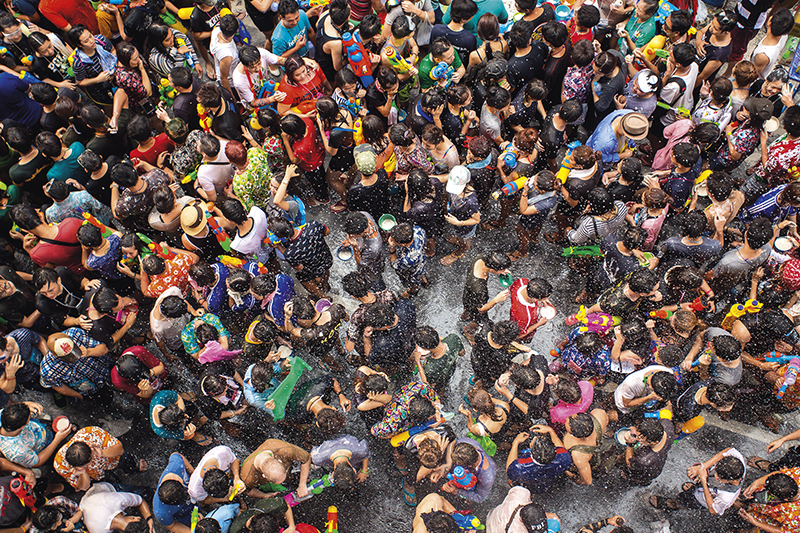
Bangkok
It’s a blast being in the capital for Songkran, when major streets like Khao San and Silom are closed to traffic and transformed into splashing battle zones. Grab a water gun – and also something to keep your phone dry!
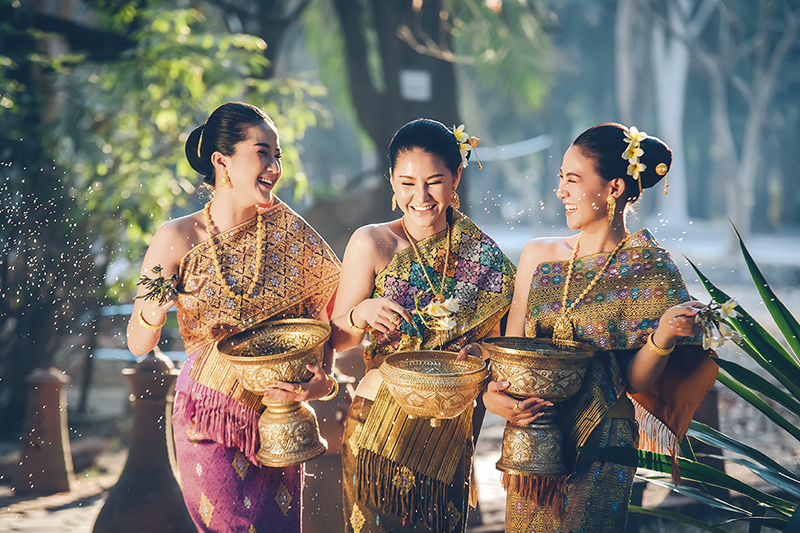
Chiang Mai
Songkran in Chiang Mai is soaked in history and tradition, highlighted by a procession bearing the Phra Buddha Sihing statue across the city. Visitors can join the parade and also participate in water battles across town.
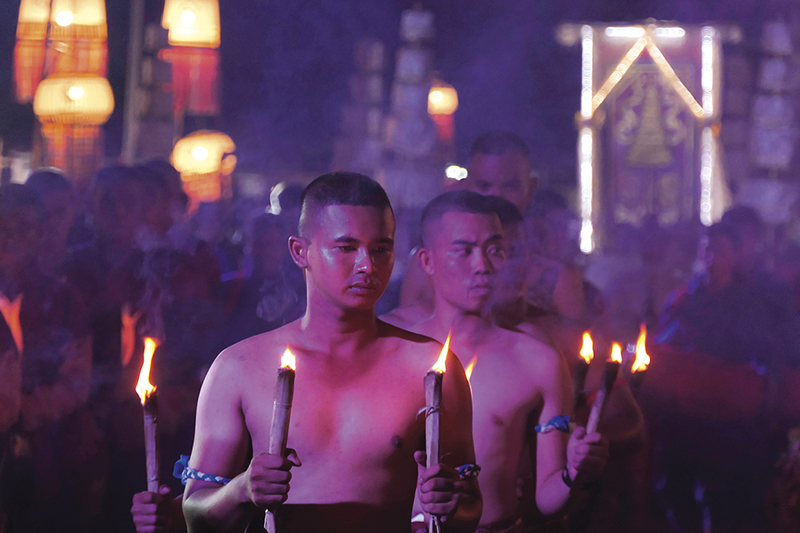
Nakhon Si Thammarat
The Nang Dan parade is a reflection of Hindu influences in the South, especially in the province of Nakhon Si Thammarat, where locals conduct special ceremonies to welcome the Hindu God Shiva to Earth. The sacred atmosphere turns spectacular when young brahmins clamber onto the giant swing and reach fearsome heights as they try to grab bags of coins hung from a nearby tree.
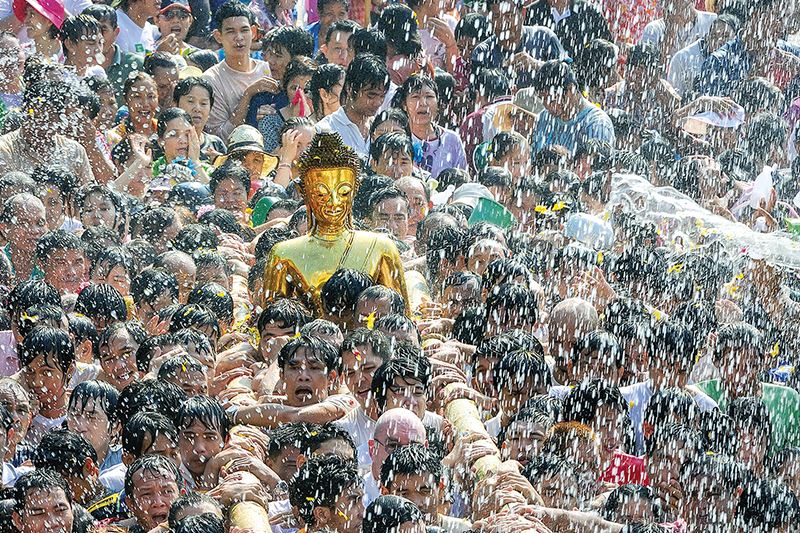
Nong Khai
For a glimpse of Songkran’s sacred side, head to this northern town on the Lao border. People in Nong Khai celebrate by carrying the century-old Phra Sai Buddha statue through the streets so locals can pay their respects and seek blessings by splashing it with water.

Hat Yai
Songkran celebrations light up the night in this southern city, as revellers join the midnight parade. A beauty contest, traditional dancing and (of course) splashing add to the fun atmosphere.
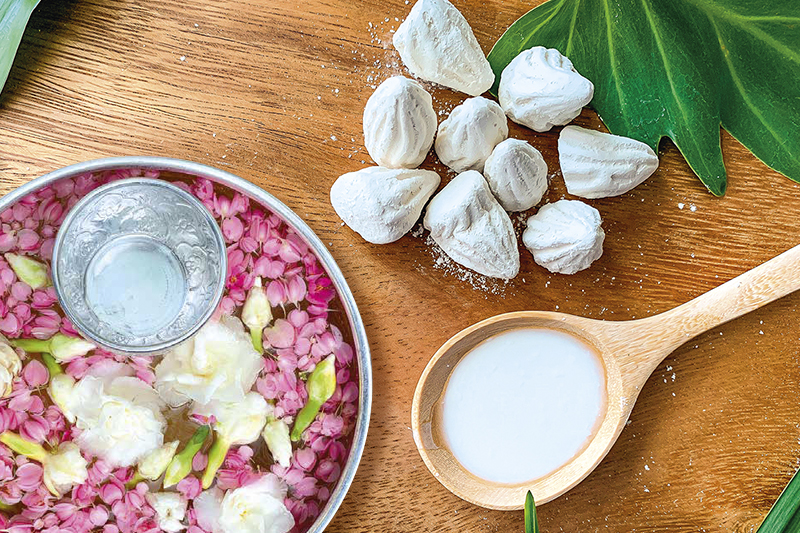
สงกรานต์คือเทศกาลทรงเอกลักษณ์ของไทย เป็นประเพณีที่สืบทอดมาหลายชั่วอายุคน ผู้คนเข้าวัดทำบุญ สรงน้ำพระ รดน้ำดำหัวผู้ใหญ่เพื่อเป็นสิริมงคล ทั้งยังเป็นช่วงเวลาที่สมาชิกในครอบครัวกลับมารวมตัวสังสรรค์กันให้หายคิดถึง
ทั่วโลกรู้จักสงกรานต์ว่าเป็นเทศกาลที่ผู้คนสาดน้ำใส่กันให้ชื่นใจ แต่ใครจะรู้ว่าเทศกาลสงกรานต์ในแต่ละภูมิภาคมีความแตกต่างกัน เรามาทำความรู้จักเพื่อเตรียมตัวรับประสบการณ์ในช่วงเทศกาลแห่งความสุขนี้กันเลย
ภาคกลาง
เริ่มต้นวันที่ 13 เมษายนของทุกปี เมื่อพระอาทิตย์เคลื่อนเข้าสู่จักรราศีเมษ นับเป็นวันสุดท้ายของปี เรียกว่า วันมหาสงกรานต์ เชื่อมเช้าสู่วันที่ 14 เมษายน เรียกว่า วันเนา ตามด้วยวันที่ 15 เมษายน เรียกว่า วันเถลิงศก หรือวันขึ้นปีใหม่ตามประเพณีไทย
ตำนานเล่าขานว่า ท้าวกบิลพรหมเสด็จลงจากสรวงสวรรค์เพื่อมาทดสอบปัญญาของธรรมบาลกุมารโดยมีศีรษะเป็นเดิมพัน เมื่อธรรมบาลกุมารสามารถตอบปัญหาได้ ท้าวกบิลพรหมจึงต้องตัดเศียรของตน แต่หากตกลงดิน พื้นดินจะลุกเป็นไฟ หากโยนขึ้นฟ้า ฝนจะไม่ตกตามฤดูกาล หากทิ้งลงมหาสมุทร น้ำจะเหือดแห้ง ธิดาของท้าวกบิลพรหมจึงต้องสลับเปลี่ยนนำเศียรของบิดาวนรอบเขาพระสุเมรุ เกิดเป็นประเพณีแห่นางสงกรานต์นั่นเอง
ภาคเหนือ
ชาวเหนือเฉลิมฉลองปีใหม่เมือง หรือปี๋ใหม่เมืองตามประเพณีล้านนา โดยจุดประทัดขับไล่สิ่งชั่วร้าย ทำความสะอาดบ้านเรือน และสวมเสื้อผ้าชุดใหม่ในวันที่ 13 เมษายน ในวันที่ 14 ทุกคนห้ามพูดคำหยาบคายเพราะเชื่อว่าจะนำมาซึ่งเคราะห์ร้าย นอกจากนี้ทุกคนจะเตรียมอาหารโดยเฉพาะลาบ (ออกเสียงเหมือนคำว่า “ลาภ”) เพื่อเป็นสิริมงคลในการเลี้ยงสังสรรค์ช่วงวันที่ 15 เมษายน ซึ่งถือเป็นวันขึ้นปีใหม่
ภาคตะวันออกเฉียงเหนือ
บุญสงกรานต์ หรือบุญเดือนห้า ถือเป็นส่วนหนึ่งของการทำบุญประจำเดือนในวันขึ้น 15 ค่ำ ชาวอีสานจะทำบุญเลี้ยงพระ สรงน้ำพระพุทธรูปและพระสงฆ์ และรดน้ำดำหัวผู้ใหญ่เพื่อเป็นสิริมงคล จากนั้นทุกคนจะช่วยกันขนทรายเข้าวัดก่อเจดีย์ทราย เพื่อนำเศษดินทรายที่ติดเท้าออกไปจากวัดตลอดทั้งปีมาคืนวัดและถวายเป็นพุทธบูชาแด่องค์พระสัมมาสัมพุทธเจ้า จากนั้นประดับตกแต่งด้วยดอกไม้และธงหลากสี ตบท้ายด้วยสมาชิกในครอบครัวจะรวมตัวกันเพื่อเล่นน้ำสงกรานต์
ภาคใต้
คนใต้เชื่อว่าเทศกาลสงกรานต์ หรือที่เรียว่า วันว่าง คือช่วงที่เจ้าเมืองใหม่จะมาปกปักษ์รักษาเมืองแทนเจ้าเมืองเก่า โดยวันที่ 13 เมษายนถือเป็นวันส่งเจ้าเมืองเก่า โดยทุกคนต้อง ‘ว่าง’ ไม่ทำงานในวันนี้ และต้อง ‘วาง’ คือ ไม่ทำร้ายผู้อื่นทั้งทางกาย วาจา ใจ และต้องไม่พูดปดและทำจิตใจให้แจ่มใสตลอดช่วงสามวันของสงกรานต์ ส่วนวันสุดท้าย วันที่ 15 เมษายน เรียกว่า วันรับเจ้าเมือง ผู้คนจะสวมเสื้อผ้าอาภรณ์ใหม่และอาบน้ำสระผมเพื่อต้อนรับปีที่จะมาถึง

สงกรานต์เที่ยวไหนดี
หนองคาย
ชมขบวนแห่หลวงพ่อพระใสบนคานหามไม้ไผ่ พร้อมกับผู้คนที่รอคอยสาดน้ำสรงพระเพื่อแสดงความเคารพและขอพรเพื่อความเป็นสิริมงคลกับชีวิต
เชียงใหม่
เชียงใหม่ได้รับความนิยมอย่างมากในช่วงสงกรานต์ เพราะมีประเพณีเก่าแก่สืบทอดต่อกันมา โดยมีขบวนแห่พระพุทธสิหิงค์รอบเมือง และมีการเล่นสาดน้ำรอบคูเมืองอีกด้วย
นครศรีธรรมราช
พิธีแห่นางดานตามความเชื่อของศาสนาพราหมณ์เพื่อรับเสด็จพระศิวะสู่โลกมนุษย์ พร้อมกับพิธีพราหมณ์อย่างการแข่งโล้ชิงช้า เปรียบเสมือนการอัญเชิญพระศิวะให้ประทับบนเขาพระสุเมรุ ในขณะที่พญานาคร่วมกันกวนน้ำมหาสมุทรเพื่อทดสอบความมั่นคงของพื้นปฐพีที่พระพรหมสร้างขึ้น
หาดใหญ่
ชมขบวนแห่ยามเที่ยงคืนและการประกวดนางสงกรานต์ พร้อมกับการละเล่นหลากหลายและการรำมโนราห์อันเป็นเอกลักษณ์งดงาม
กรุงเทพฯ
อย่าพลาดการเล่นน้ำสงกรานต์ในมหานครกรุงเทพฯ ที่ที่ถนนหลายสายปิดเพื่อให้เล่นสาดน้ำกันโดยเฉพาะ ไม่ว่าจะเป็นถนนข้าวสาร ย่านนักท่องเที่ยวและย่านธุรกิจสุดคึกคักบนถนนสีลม
